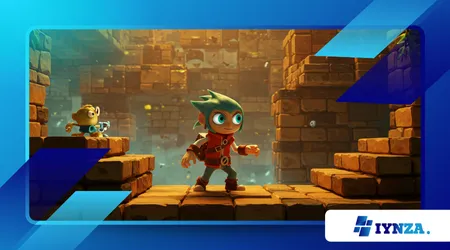Why 2025 Feels Like 1995: The Unexpected Revival of 2D Platformers

There was a time when 2D platformers dominated every console and arcade cabinet. You knew the rhythm: run, jump, time your moves perfectly.
Anúncios
Then came 3D graphics, cinematic narratives, and massive open worlds. But lately, something strange has happened. In 2025, it feels like we’re back in 1995.
The question is: why? What is pulling players—and developers—back to pixelated worlds, tight mechanics, and side-scrolling challenges?
The answer lies in a blend of nostalgia, design clarity, and a yearning for simplicity in a crowded, overstimulating digital era.
The Core Mechanics Still Work
Jumping between platforms, dodging enemies, and finding the right timing—these mechanics never stopped being fun.
They’re intuitive, challenging, and satisfying. That’s why new 2D platformers aren’t just copies of the past. They’re refined, responsive, and incredibly polished.
In fact, many indie studios now treat 2D design like a discipline, not a shortcut. The level design, hitbox precision, and movement flow are honed to perfection. Games like Celeste, Hollow Knight, and Ori and the Will of the Wisps laid the groundwork. In 2025, new titles are building on it.
This design philosophy emphasizes elegance and player agency. You learn by doing, not by being told. Mastery feels earned, not granted.
The best 2D platformers create a loop of challenge and satisfaction that keeps you playing without needing loot boxes, endless cutscenes, or artificial padding.
Players appreciate that respect for their time. And in an era of bloated 100-hour campaigns, the tight, focused nature of 2D platformers stands out as both accessible and endlessly replayable.
Read also: How Retro Gaming Influences Modern Game Design
Nostalgia Isn’t the Only Factor
It’s easy to assume the resurgence is driven by childhood memories. But that’s not the whole picture.
Gen Z gamers, who weren’t alive in 1995, are just as drawn to these experiences. The visual language of 2D sprites, chiptune music, and arcade pacing speaks to anyone who craves gameplay that’s immediate and focused.
Modern players are fatigued by long tutorials and bloated quests. 2D platformers strip all that away. You press start, and you play. That simplicity is refreshing, and it’s now part of a deliberate design philosophy.
There’s also a creative freedom to 2D that attracts artists and storytellers. Designers can make bold aesthetic choices without worrying about ultra-realism.
That opens the door to surreal environments, hand-drawn styles, and emotionally charged stories that unfold through mechanics rather than dialogue.
In short, nostalgia may open the door—but it’s fresh execution that keeps players engaged. These games aren’t looking backward. They’re using old tools to tell new stories in a way modern players actually prefer.
Tech Has Changed the Game
Back in 1995, developers were constrained by hardware. Now, 2D platformers are a choice—not a limitation.
That shift empowers creators to make beautiful pixel art with lighting effects, parallax depth, and dynamic audio that were impossible thirty years ago.
The tools available in 2025, from Unity enhancements to Godot improvements, mean small teams can build stunning, fluid experiences without AAA budgets.
That freedom fuels creativity and experimentation, leading to smarter enemies, better physics, and more responsive controls in 2D worlds.
Advanced physics engines now allow for more nuanced platforming mechanics, like real-time environmental reactions, soft body physics for characters, or fluid transitions between game layers. These additions bring new dimensions to an old formula, creating gameplay that feels fresh even when rooted in tradition.
Moreover, seamless cross-platform development means 2D games can launch on PC, Switch, mobile, and cloud services simultaneously, reaching a wide audience with minimal extra effort.
Combined with built-in accessibility features, the result is an inclusive revival that resonates globally.
A New Generation of Platforming Icons
With this revival comes new characters. Mascots like Meat Boy, Hornet, and Madeline are now as iconic as Mario or Sonic in certain circles. These characters embody modern themes: resilience, identity, mental health, discovery.
This isn’t just nostalgia—it’s evolution. 2D is becoming a platform (literally) for storytelling as much as it is for gameplay. And it’s resonating.
Narratives have matured. Today’s protagonists face internal struggles, ethical choices, and social commentary. A side-scroller might now explore depression, loneliness, or the immigrant experience—all while retaining tight platforming mechanics.
And the character design reflects this shift too. Stylized but expressive, minimal yet memorable. These aren’t just mascots—they’re avatars for emotional journeys. Their worlds might be pixelated, but their stories are profoundly human.
As more developers approach 2D as a serious storytelling medium, we’re seeing a fusion of gameplay and message that’s never existed at this scale before in the genre. And players are responding not with nostalgia—but with admiration.
What This Means for the Future of Gaming
The unexpected return of 2D platformers doesn’t mean AAA 3D games are fading. But it does prove that simplicity, polish, and heart still win players over. Developers are recognizing that you don’t need 4K textures and ray tracing to make something unforgettable.
In 2025, players are looking for joy. For challenge. For something that feels real, even if it looks pixelated. And that’s why 2025 feels a lot like 1995.
It also signals a shift in priorities. Gamers want more than just content—they want meaning. They’re drawn to experiences that are crafted, not bloated. That have identity, not just spectacle.
Expect to see more hybrid approaches in the years ahead. 2.5D, narrative-driven platformers, metroidvania twists, cooperative mechanics—2D isn’t a genre anymore. It’s a canvas. And the new generation of developers is painting masterpieces on it.
FAQ: Questions About Revival of 2D Platformers
1. Are Revival of 2D Platformers only popular among older gamers?
No. Players of all ages are enjoying them, especially Gen Z and indie fans who appreciate tight gameplay and stylized visuals.
2. What are the best 2D platformers in 2025?
Titles like Moonsight, Daggerloop, and Echo Vale are getting attention this year for innovative mechanics and beautiful design.
3. Why are indie developers choosing 2D over 3D?
Because it allows more control, faster iteration, and better polish without massive teams or budgets.
4. Will AAA studios return to 2D platformers?
Some already have. Ubisoft and Capcom have experimented with high-budget 2D titles recently.
5. What makes a good modern 2D platformer?
Precision, flow, responsive controls, and an emotional hook—not just nostalgia.
